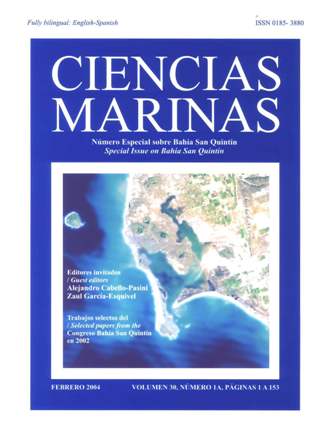Use of digital multispectral videography to assess seagrass distribution in San Quintín Bay, Baja California, Mexico
Main Article Content
Abstract
Apparent threats to the spatial distribution of seagrass in San Quintín Bay prompted us to make a detailed assessment of habitats in the bay. Six coastal habitats and three seagrass subclasses were delineated using airborne digital multispectral videography (DMSV). Eelgrass, Zostera marina, was the predominant seagrass and covered 40% (1949 ha) of the areal extent of the bay in 1999. Eelgrass grew over a wide range of tidal depths from about –3.0 m mean lower low water (MLLW) to about 1.0 m MLLW, but greatest spatial extent occurred in intertidal areas –0.6 m to 1.0 m MLLW. Exposed-continuous (i.e., high density) eelgrass was the most abundant habitat in the bay. Widgeongrass, Ruppia maritima, was the only other seagrass present and covered 3% (136 ha) of the areal extent of the entire bay. Widgeongrass grew in single species stands in the upper intertidal (≥ 0.4 MLLW) and intermixed with eelgrass at lower tidal depths. Overall accuracy of the six habitat classes and three subclasses in the DMSV map was relatively high at 84%. Our detailed map of San Quintín Bay can be used in future change detection analyses to monitor the health of seagrasses in the bay.
Downloads
Article Details
This is an open access article distributed under a Creative Commons Attribution 4.0 License, which allows you to share and adapt the work, as long as you give appropriate credit to the original author(s) and the source, provide a link to the Creative Commons license, and indicate if changes were made. Figures, tables and other elements in the article are included in the article’s CC BY 4.0 license, unless otherwise indicated. The journal title is protected by copyrights and not subject to this license. Full license deed can be viewed here.

